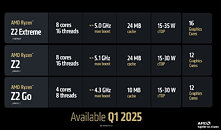
Lenovo Introduces New ThinkPad Mobile Workstations and Business Laptops Designed for the AI-Ready Workforce
Lenovo today unveiled a refreshed portfolio of ThinkPad devices engineered to meet the evolving needs of modern professionals—from content creators and engineers to knowledge workers and hybrid teams. The lineup includes powerful Copilot+ PCs, such as the ThinkPad P14s Gen 6 AMD and ThinkPad P16s Gen 4 AMD mobile workstations, alongside new ThinkPad L Series business laptops and expands its ThinkPad X1 Aura Editions, delivering the performance, manageability, and intelligence today's AI-powered workflows demand.
Together, these latest ThinkPad systems reflect Lenovo's commitment to delivering smarter, more adaptive solutions that support advanced workloads, sustainability goals, and flexible work models—whether users are building complex simulations or collaborating across teams.
Together, these latest ThinkPad systems reflect Lenovo's commitment to delivering smarter, more adaptive solutions that support advanced workloads, sustainability goals, and flexible work models—whether users are building complex simulations or collaborating across teams.



























































































